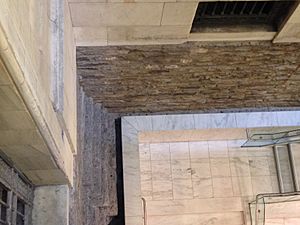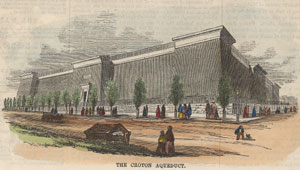Croton Distributing Reservoir facts for kids
The Croton Distributing Reservoir, also known as the Murray Hill Reservoir, was a huge water tank in New York City. It was located in Manhattan at 42nd Street and Fifth Avenue. This reservoir was built above ground and covered about 4-acre (16,000 m2). It could hold 20 million US gallons (76,000 m3) of water. In the 1800s, it provided drinking water for the city.
The reservoir had very strong walls made of granite. These walls were 50-foot-high (15 m) and 25 feet (7.6 m) thick. They looked a bit like ancient Egyptian buildings. On top of the walls, there was a public walkway. People could walk there and enjoy great views of the city. Even the famous writer Edgar Allan Poe liked to walk there.
The water for the reservoir came from the Croton Aqueduct. This aqueduct was New York City's main water source back then. Before the aqueduct, people got water from wells, cisterns, and rain barrels. The aqueduct and reservoir got their names from the Croton River. This river is in northern Westchester County. The aqueduct was a series of mostly underground pipes that brought water from the river all the way to New York City. The reservoir started filling with water on July 4, 1842, which was a big celebration!
Why the Reservoir Was Taken Down


The Croton Distributing Reservoir was taken down in the 1890s. Today, the main branch of the New York Public Library stands in its place. This library is next to Bryant Park. You can still see some of the reservoir's original foundation. It is in the South Court area of the library.
New York City now gets its water mainly through three large underground tunnels. The Central Park Reservoir is still there, but it stopped being part of the Croton Aqueduct system in 1993.
If you ride the subway, you can see old photos of the reservoir. There's a display on the wall in the underground tunnel. This tunnel connects the Fifth Avenue station on the New York City Subway's IRT Flushing Line (7 <7> trains) and the 42nd Street–Bryant Park station on the IND Sixth Avenue Line (B D F M trains).
Building the Croton Aqueduct and Reservoir
A few years before the reservoir was taken down, two special plaques were placed on its walls. They told the story of how the Croton Aqueduct and Reservoir were built. Here are some interesting facts from those plaques:
- The law to build the aqueduct was passed on May 2, 1834.
- Commissioners like Stephen Allen and William W. Fox were appointed to oversee the project.
- In 1835, most New Yorkers voted to build the aqueduct.
- Construction started in May 1837.
- David B. Douglass was the first Chief Engineer, followed by John B. Jervis.
- On June 22, 1842, the aqueduct was ready to receive water from the Croton River Lake.
- Water reached the Receiving Reservoir on June 27, 1842.
- The water finally entered the Distributing Reservoir on July 4, 1842.
The plaques also shared some impressive numbers about the project:
- The dam at the Croton River was 40 feet (12 m) high.
- The Croton River Lake was 5 miles (8.0 km) long and covered 400 acres (1,600,000 m2).
- The aqueduct from the dam to the Distributing Reservoir was 40.5 miles (65.2 km) long.
- It could deliver 60,000,000 imperial gallons[convert: unknown unit] of water every 24 hours.
- The Receiving Reservoir held 150,000,000 US gallons (570,000 m3).
- The Distributing Reservoir held 20,000,000 US gallons (76,000 m3).
- The total cost of the project, up to and including the reservoir, was nearly $9,000,000.
The second plaque listed the main people involved in the project:
- Commissioners: Samuel Stevens, Zebedee Ring, John D. Ward, Benjamin Birdsall, Samuel R. Childs.
- Engineers: John B. Jervis (Chief), H. Allen (Principal Assistant), P. Hastie (Resident).
- Builders: Thomson Price & Son.
The construction of the reservoir started in 1838 and was finished in 1842.
See also
 In Spanish: Depósito Croton (Nueva York) para niños
In Spanish: Depósito Croton (Nueva York) para niños


